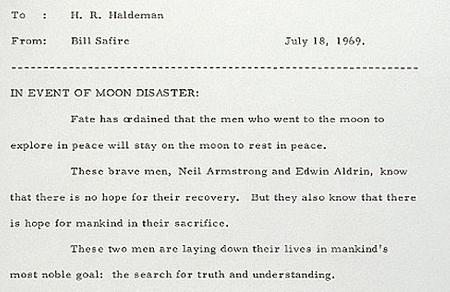Marooned on the Moon

Sometimes, the grandest plans go awry. And because of that, we often plan for the worst-case scenario.
On July 20, 1969, astronauts Neil Armstrong and Buzz Aldrin disembarked from a lunar lander, becoming the first people, ever, to walk on the moon. The landing, per NASA, was not the troubling part. Rather, NASA’s biggest concern was whether the lunar lander would be able to leave the moon’s surface and return to the lunar orbiter, piloted and manned by Michael Collins, awaiting them for the return to Earth. If the lunar lander’s liftoff failed, both Armstrong and Aldrin would be marooned on the moon, with the world watching on television.
Then-President Richard M. Nixon’s speechwriter, William Safire (who would later become a New York Times writer), took it upon himself to draft a plan and a message from Nixon in case of this disaster. That message, seen in part above (bigger, full version here), outlined the plan. First, Nixon would call (in Safire’s words) the “widows-to-be,” offering the nation’s condolences. Then, communications with the moon would be cut, and a member of the clergy would offer a prayer similar to one used for a burial at sea, and closing with the Lord’s Prayer. Finally, Nixon would read the following statement to those watching on television:
Fate has ordained that the men who went to the moon to explore in peace will stay on the moon to rest in peace.
These brave men, Neil Armstrong and Edwin Aldrin, know that there is no hope for their recovery. But they also know that there is hope for mankind in their sacrifice.
These two men are laying down their lives in mankind’s most noble goal: the search for truth and understanding. They will be mourned by their families and friends; they will be mourned by their nation; they will be mourned by the people of the world; they wil be mourned by a Mother Earth that dared send two of her sons into the unknown.
In their exploration, they stirred the people of the world to feel as one; in their sacrifice, they bind more tightly the brotherhood of man.
In ancient days, men looked at stars and saw their heroes in the constellations. In modern times, we do much the same, but our heroes are epic men of flesh and blood.
Others will follow, and surely find their way home. Man’s search will not be denied. But these men were the first, and they will remain the foremost in our hearts.
For every human being who looks up at the moon in the nights to come will know that there is some corner of another world that is forever mankind.
The address was never used, and it’s unclear if Nixon himself ever knew of its existence until well afterward. The astronauts, however, did learn of it. In 1999, in celebration of the 30th anniversary of the successful moon landing, the late Tim Russert had Aldrin, Armstrong, and Collins on Meet the Press and read the statement to them.
Bonus fact: On June 6, 1944, Allied forces successfully pulled off the now-famous D-Day landing on Normandy Beach, France, a tide-turning victory in World War II. Had it failed, then-General Dwight D. Eisenhower was prepared to issue a statement, seen here, taking the blame for the defeat. Having a lot on his mind, he dated the draft incorrectly — it reads “July 5.” Safire cited Eisenhower’s decision to draft a worst-case-scenario statement as his reason to do the same for the moon landing.
From the Archives: Mirror, Mirror, On The Moon: Over the course of the Apollo missions, astronauts left a few items behind on their moon visits. Some mirrors are still there — and still in use.
Related: “Lend Me Your Ears: Great Speeches in History,” curated by Safire himself. 4.5 stars on Amazon on 22 reviews, $24.95.

Leave a comment